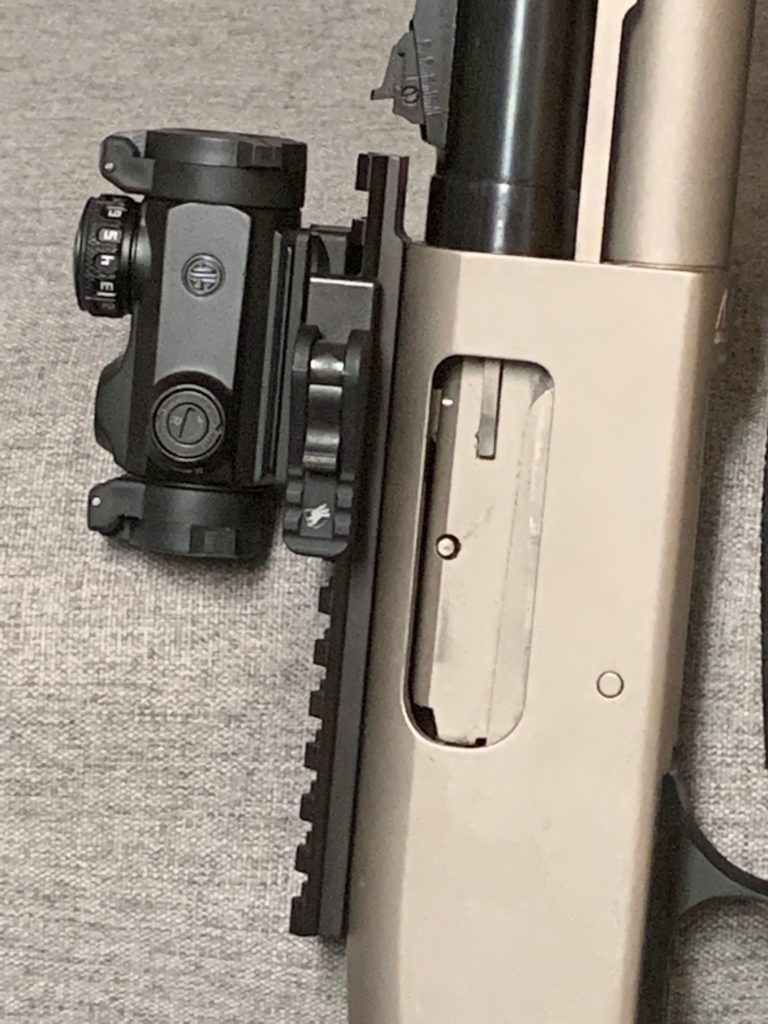I have had a red-dot sight ready to mount on a shotgun for almost a year now. Part of what was holding me back is that I already had an existing red dot sight mounted and sited in so I wasn’t going to replace it until I got to a point were sighting in was next on my agenda. Otherwise I would end up with a non-functional firearm.
Times and plans have changed. I started writing this over two weeks ago with plans to go to the range on the weekend. I got busy, plans changed and I went ahead and swapped the sight out with the intention to sight it in. This post is not about my failures, but more to learn something.
I actually learned something. When I bought the sight, it is setup (height wise) to be used on an AR. Something I don’t really understand is why those sights stand so high, 1 1/2″ above the barrel. The best bore line from a physics point of view is as close as you can get to the barrel. At an exorbitant cost of $90, I got what is called a low-mount base.

When I finally decided to mount the sight, the existing sight I had on was called a Weaver mount (left below). It is a series of slots on an aluminum plate that a screw sits in the slot and clamps two dovetail ends over the rail. It is a pretty simple and strong connection compared to other existing solutions.
But the new sight has what is called a picatinny connection (right below). This is very similar to a Weaver only larger slots. It is used in mil-spec or tactical applications. That means, I needed to also replace the plate to mount the sight.

If you are like me and never paid much attention to the jargon, Weaver bases can be mounted on picatinny rails but not vice versa because of the size of the mounting screw and the slot. I suppose if you do a lot of swapping, then you probably know all of this. But hopefully is is helpful for people like me.
A couple of other notes here. First, sights are not allowed in clay sports such as trap and sporting clays. That is largely because they are not allowing in bird hunting, with the exception of turkeys. I think sights are encouraged in other shooting sports like three gun and it is a really good idea if you are hunting with slugs. Finally, sights are also encouraged in self defense setups. So, know what you are aiming for, it can help with the decision to use or not use sights. Remember too that you should check your sights each time you remove them as the point of impact may have shifted. So, don’t plan on willy-nilly changing with repeatable results. I haven’t had any problems but I also don’t do it a lot and I check them.
This is less about attachment types and more about sights themselves. Red dots tend to specify 2-5 Minutes of Accuracy (MOA). The more inexpensive, the greater the MOA rating. Taking a 5 MOA sight, that means that at 100 yards, you should expect a group of 5 inches. The closer you are, the smaller your expected groups, in general. For precision shooting, use a rifle (preferred) or traditional glass scope (better). But slugs should be limited in range because of low velocity and high mass causes large drop over long distances.
End Your Programming Routine: It seems like people generally fall into two camps. There are the hunter and the tactical leaning types. Weaver bases are more prevalent on the hunting side and picatinny more on the tactical side. I personally think Weaver sights are more petit and make a firearm look better, not that it really matters. But, picatinny are more universal and for that reason more practical.
Recent Comments